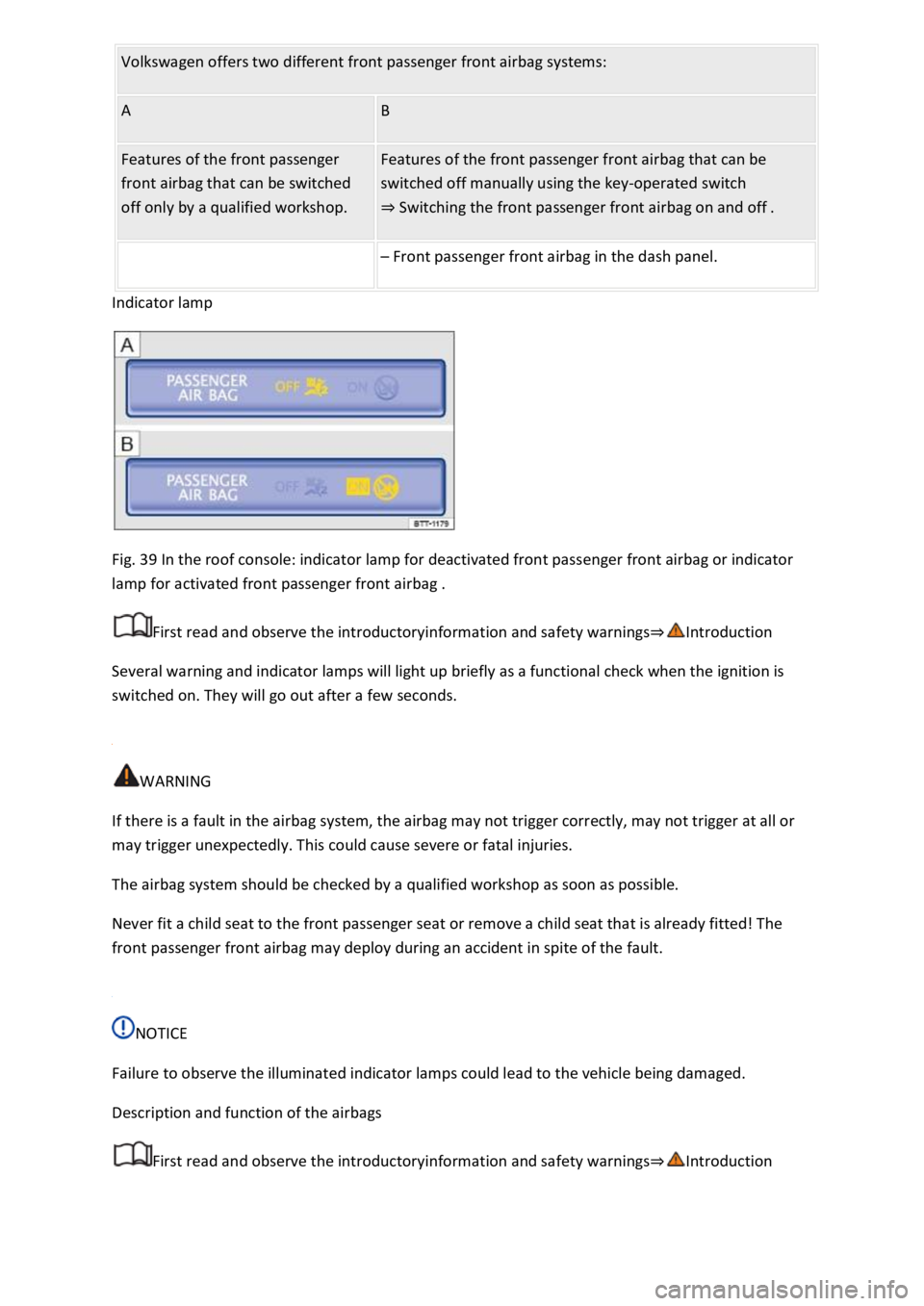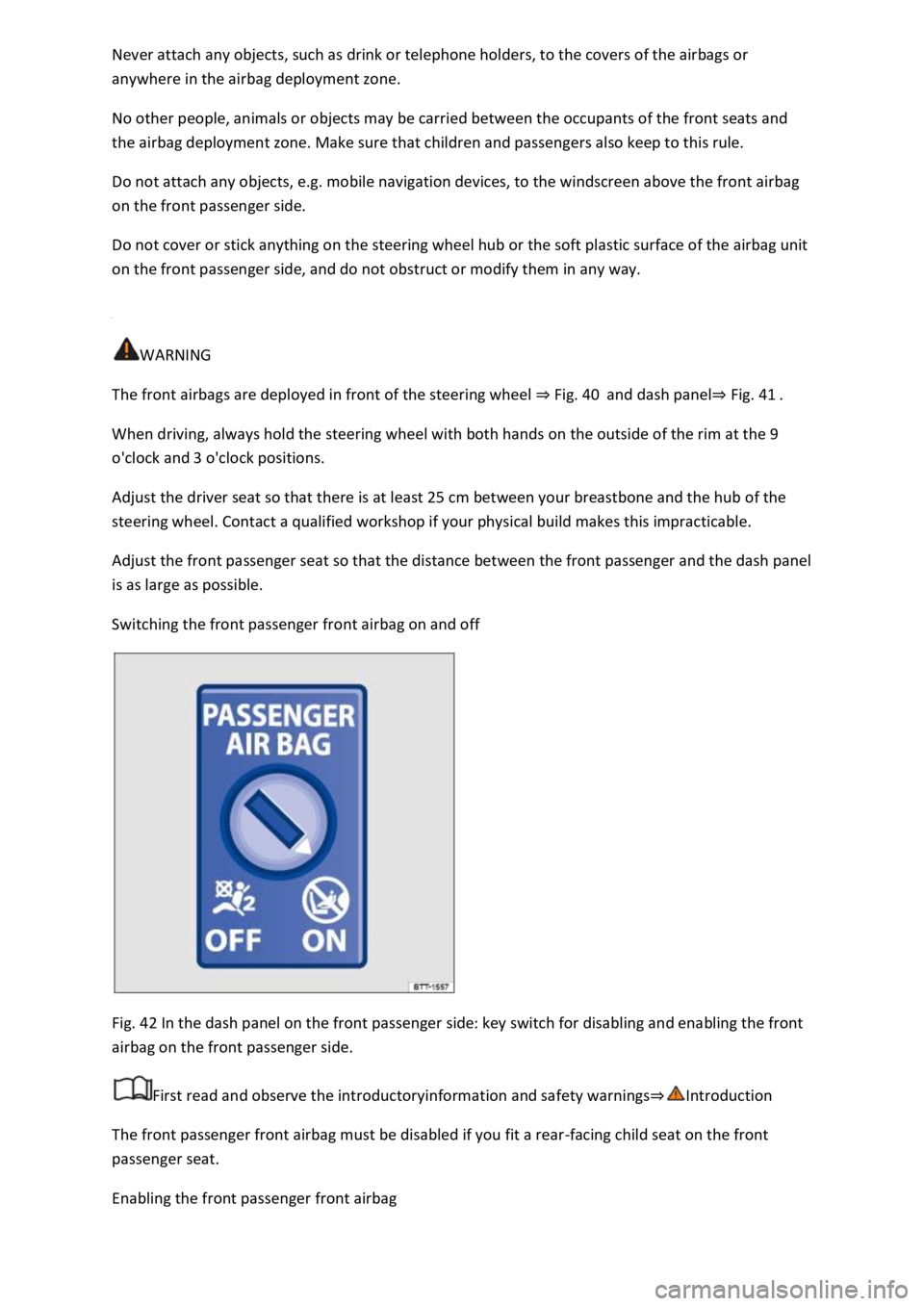2019 VOLKSWAGEN T-ROC child seat
[x] Cancel search: child seatPage 47 of 502

Checklist
Observe the following information both before and during every journey to ensure your own safety,
and the safety of all passengers and other road users
Check that all lights and turn signals are working properly.
Check the tyre pressure and fuel level Tyre pressure, Fuel gauge.
Check the washer fluid level Washer fluid.
Make sure that you have a good, clear view through all of the windows Caring for and cleaning the
vehicle exterior.
Secure any objects and luggage in the stowage compartments, the luggage compartment or on the
roof Transporting items.
Ensure that you are able to operate the pedals freely at all times.
Secure any children travelling in the vehicle in a restraint system suitable for their weight and size
Safe transport of children.
Adjust the front seats, head restraints and mirrors properly to match the size of the occupants
Sitting position, Mirrors.
Wear shoes that provide proper support for your feet when using the pedals.
The floor mat in the footwell on the driver side must leave the pedal area free and must be securely
fastened.
Page 51 of 502

not only about vehicle maintenance it also ensures that your vehicle
remains roadworthy and in perfect working order. You should therefore have your vehicle serviced
according to the Volkswagen guidelines. Some work may have to be carried out before the date of
the next service if the vehicle is subjected to severe operating conditions. Severe operating
conditions are, for example, regular stop-and-go driving or driving in areas with high levels of dust.
Further information can be obtained from your Volkswagen dealership or qualified workshop.
Sitting position
Introduction
This chapter contains information on the followingsubjects:
Dangers of assuming an incorrect sitting position
Correct sitting posi
Number of seats
The vehicle has a total of five seats: two at the front and three at the rear.
Each seat is equipped with a seat belt.
WARNING
Assuming an incorrect sitting position in the vehicle can increase the risk of severe or fatal injuries
during a sudden driving or braking manoeuvre in the event of a collision or accident or if the airbags
are triggered.
All vehicle occupants must assume a correct sitting position before setting off and maintain this
position throughout the trip. This also applies for the fastening of seat belts.
The number of vehicle occupants must never exceed the number of seats with seat belts in the
vehicle.
Always secure children in the vehicle in an authorised child restraint system which is suitable for
their height and weight Safe transport of childrenand Airbag system
Always keep your feet in the footwell while the vehicle is in motion. Never place your feet on the
seat or dash panel, for example, and never ride with your feet out of the window. The airbag and
seat belt can otherwise not provide optimal protection and can actually increase the risk of injury
during an accident.
Dangers of assuming an incorrect sitting position
First read and observe the introductoryinformation and safety warnings
If the seat belts are not worn or are worn incorrectly, the risk of severe or fatal injuries increases.
Seat belts can provide optimal protection only if seat belt routing is correct. An incorrect sitting
position considerably impairs the level of protection provided by a seat belt. This could lead to
severe or even fatal injuries. The risk of severe or fatal injuries is especially increased when a
Page 52 of 502

is responsible for all occupants transported in the vehicle, especially children.
The following list contains examples of sitting positions that can be dangerous for all vehicle
occupants.
Whenever the vehicle is in motion:
Never stand in the vehicle.
Never stand on the seats.
Never kneel on the seats.
Never tilt the backrest too far to the rear.
Never lean against the dash panel.
Never lie on the seats in the passenger compartment and on the rear bench seat.
Never sit on the front edge of a seat.
Never sit sideways.
Never lean out of a window.
Never put your feet out of a window.
Never put your feet on the dash panel.
Never place your feet on the seat cushion or seat backrest.
Never travel in a footwell.
Never sit on the armrests.
Never travel on a seat without wearing the seat belt.
Never travel in the luggage compartment.
WARNING
Every incorrect sitting position in the vehicle increases the risk of severe or fatal injuries in the event
of an accident or sudden driving or braking manoeuvre.
All vehicle occupants must maintain a correct sitting position and wear their seat belt properly while
the vehicle is in motion.
Sitting in an incorrect position, not fastening the seat belt, or not leaving adequate space between
the occupants and the airbags could inflict critical or fatal injuries, especially if the airbags deploy
and strike an occupant who has assumed an incorrect sitting position.
Correct sitting position
Page 55 of 502

seat belt belonging to their seat and keep it fastened properly throughout the trip. This applies to all
vehicle occupants and also in urban traffic.
While the vehicle is in motion, secure all children travelling in the vehicle in a restraint system
suitable for their weight and height. They must also wear correctly fastened seat belts Safe
transport of children
Drive off only when all passengers have correctly fastened their seat belts.
Never insert the latch plate into a buckle which does not belong to the corresponding seat and
always ensure it engages properly. Using a buckle which does not belong to the seat you are
occupying reduces the level of protection and can lead to severe injuries.
Never let any foreign bodies or liquids get into the slots for the belt buckles. This could prevent the
belt buckle and seat belt from working properly.
Never unfasten the seat belt while the vehicle is in motion.
Never allow more than one person to share the same seat belt.
Never travel when children or babies are being carried on somebody's lap and fastened with the
same belt.
Never travel wearing loose, bulky clothing (such as an overcoat over a jacket). This could prevent the
seat belts from fitting and functioning properly.
WARNING
Damaged seat belts are very dangerous and could cause severe or fatal injuries.
Never damage the belt by trapping it in the door or in the seat mechanism.
If the belt webbing or any other part of the seat belt becomes damaged, the seat belts may tear
during an accident or sudden braking manoeuvre.
Have damaged seat belts immediately replaced by new seat belts that have been approved by
Volkswagen for the vehicle. Seat belts subjected to stress and stretched during an accident must be
replaced by a qualified workshop. Renewal may be necessary even if there is no apparent damage.
The belt anchorage should also be checked.
Never try to repair, modify or remove the seat belts yourself. All repairs to the seat belts, belt
retractors and buckles must be carried out by a qualified workshop.
Warning lamp
Page 68 of 502

Never rely on the airbag system exclusively for your protection.
The airbag has merely a supportive function for your protection, even if it is triggered.
The airbag system offers the best level of protection and reduces the risk of injury when seat belts
are properly worn Seat belts
Before every trip, each vehicle occupant must adopt the correct sitting position, correctly fasten the
seat belt belonging to their seat and keep it fastened properly throughout the trip. This applies to all
vehicle occupants and also in urban traffic.
WARNING
The risk of injury increases if there are any objects located between the vehicle occupants and the
deployment area of the airbag when it is triggered. This will impinge on the deployment zone of the
airbag or the items will be flung against the body.
Never hold any objects in your hands or on your lap while the vehicle is in motion.
Never transport any objects on the front passenger seat. The objects could enter into the
deployment zone of the airbag during sudden braking or driving manoeuvres and then be flung
dangerously through the vehicle interior if the airbag is activated.
Vehicle occupants sitting on the front seats and rear outer seats must never carry any people, pets
or objects in the deployment zone between themselves and the airbags. Make sure that children and
passengers also keep to this rule.
WARNING
The airbag system can be triggered only once. The system will have to be replaced if the airbags have
been triggered.
Airbags that have been triggered, and any affected system parts, must immediately be replaced with
new parts that are approved by Volkswagen for the vehicle.
Repairs and modifications to your vehicle should be carried out only by a qualified workshop.
Qualified workshops have the necessary tools, diagnostic equipment, repair information and
qualified personnel.
Never use recycled airbag components or components that have been taken from end-of-life
vehicles in your vehicle.
Never alter any components of the airbag system.
WARNING
Page 70 of 502

Fig. 39 In the roof console: indicator lamp for deactivated front passenger front airbag or indicator
lamp for activated front passenger front airbag .
First read and observe the introductoryinformation and safety warnings
Several warning and indicator lamps will light up briefly as a functional check when the ignition is
switched on. They will go out after a few seconds.
WARNING
If there is a fault in the airbag system, the airbag may not trigger correctly, may not trigger at all or
may trigger unexpectedly. This could cause severe or fatal injuries.
The airbag system should be checked by a qualified workshop as soon as possible.
Never fit a child seat to the front passenger seat or remove a child seat that is already fitted! The
front passenger front airbag may deploy during an accident in spite of the fault.
NOTICE
Failure to observe the illuminated indicator lamps could lead to the vehicle being damaged.
Description and function of the airbags
First read and observe the introductoryinformation and safety warnings
Page 71 of 502

vehicle occupants during frontal and side collisions by reducing their
movement in the direction of the collision.
Each triggered airbag is filled by a gas generator. This causes the airbag covers to break open and the
airbags inflate forcefully to cover their deployment zones within milliseconds. Once a vehicle
occupant wearing a seat belt starts to sink into the inflated airbag, the gas inside the airbag starts to
escape to cushion the occupant and slow down their movement. This reduces the risk of severe and
fatal injuries. A triggered airbag will not always prevent other injuries from occurring, such as
swelling, bruising, burning and grazing. Deployment of an airbag can also result in frictional heat.
The most important factors for triggering the airbag are the type of accident, the angle of impact,
the vehicle speed and the type of object with which the vehicle collides. Therefore, visible damage
to the vehicle does not always mean that the airbag should have been triggered.
The triggering of the airbag system depends on the vehicle deceleration rate caused by the collision
and registered by the electronic control unit. If this rate is below the reference value programmed
into the control unit, the airbags will not be triggered, even though the vehicle may be badly
damaged as a result of the collision. Vehicle damage, repair costs or even the lack of vehicle damage
in an accident is not necessarily an indication of whether an airbag should inflate or not. It is not
possible to define a range of vehicle speeds and reference values, since the circumstances will vary
considerably between one collision and another. It is therefore impossible to cover every possible
kind and angle of impact that would trigger the airbags. Important factors in the triggering of the
airbag include, for example, the nature (hard or soft) of the object that the vehicle hits, the angle of
impact as well as vehicle speed.
Airbags serve only as a supplement to the three-point seat belt in some accident situations when the
vehicle's deceleration is sufficient to trigger the airbags. Airbags can be triggered only once and only
in certain situations. The seat belts are always there to provide protection in situations when the
airbags are not triggered or have already been triggered. For example, if the vehicle collides with a
further vehicle following the initial collision, or is hit by another vehicle.
The airbag system is part of the vehicle's overall passive safety concept. The airbag system can work
effectively only when the occupants are wearing their seat belts correctly and have assumed a
proper sitting position Sitting position
Components of the vehicle safety concept
The following vehicle safety equipment makes up the vehicle's safety concept to reduce the risk of
severe and fatal injuries. Depending on the vehicle equipment level, some of the equipment may not
be fitted in your vehicle or may not be available in some countries.
Optimised seat belts for all seats.
Front airbags for driver and front passenger.
Airbag indicator lamp .
Control units and sensors.
Adjustable steering column.
If applicable, mounting points for the top tether for child seats.
Page 73 of 502

anywhere in the airbag deployment zone.
No other people, animals or objects may be carried between the occupants of the front seats and
the airbag deployment zone. Make sure that children and passengers also keep to this rule.
Do not attach any objects, e.g. mobile navigation devices, to the windscreen above the front airbag
on the front passenger side.
Do not cover or stick anything on the steering wheel hub or the soft plastic surface of the airbag unit
on the front passenger side, and do not obstruct or modify them in any way.
WARNING
The front airbags are deployed in front of the steering wheel Fig. 40and dash panelFig. 41
When driving, always hold the steering wheel with both hands on the outside of the rim at the 9
o'clock and 3 o'clock positions.
Adjust the driver seat so that there is at least 25 cm between your breastbone and the hub of the
steering wheel. Contact a qualified workshop if your physical build makes this impracticable.
Adjust the front passenger seat so that the distance between the front passenger and the dash panel
is as large as possible.
Switching the front passenger front airbag on and off
Fig. 42 In the dash panel on the front passenger side: key switch for disabling and enabling the front
airbag on the front passenger side.
First read and observe the introductoryinformation and safety warnings
The front passenger front airbag must be disabled if you fit a rear-facing child seat on the front
passenger seat.
Enabling the front passenger front airbag